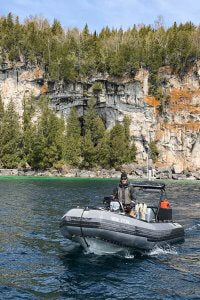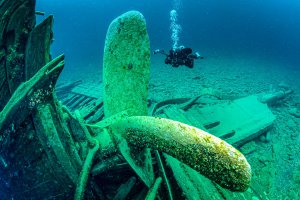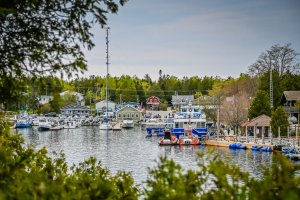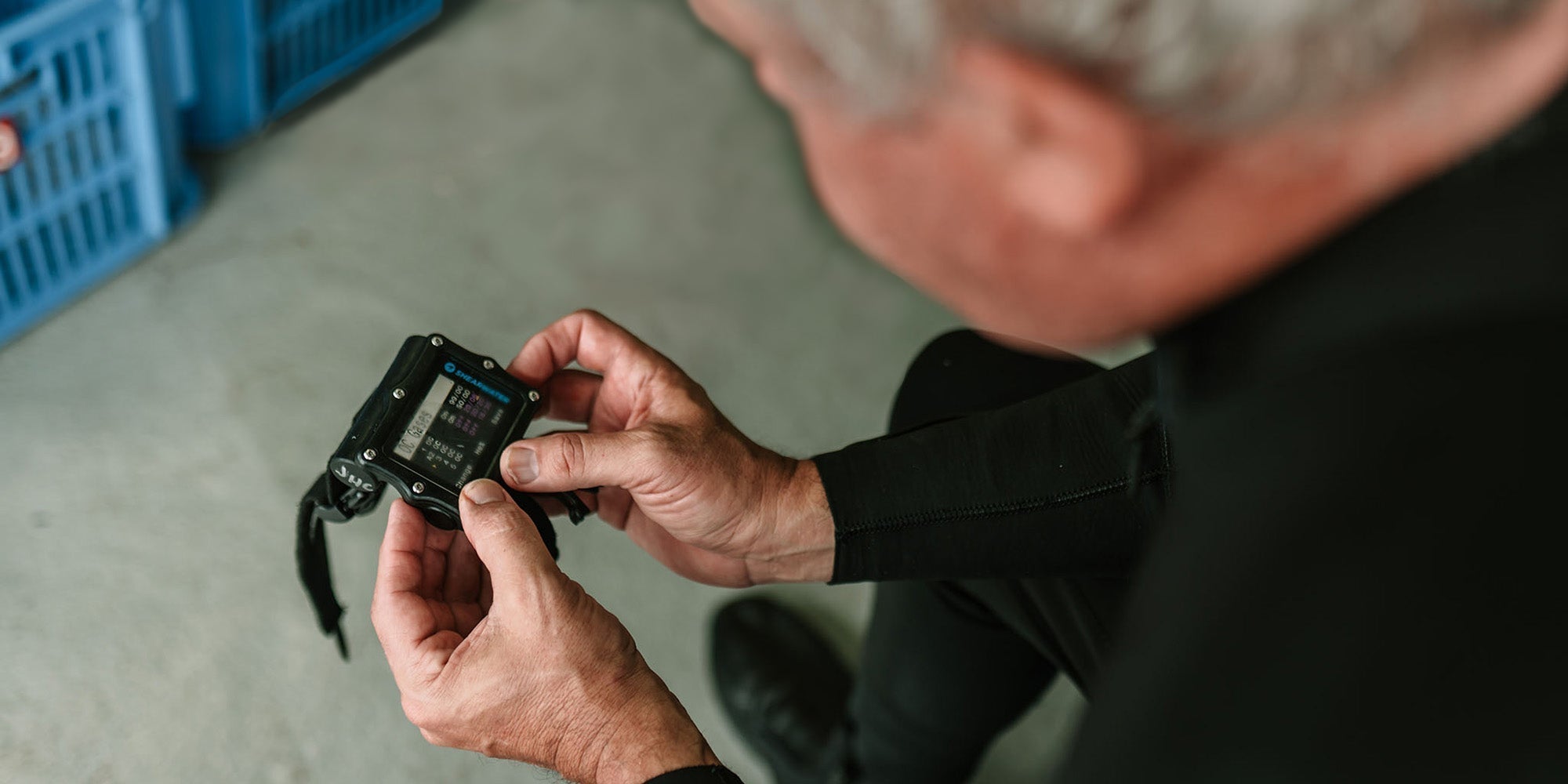 Niagara II shipwreck. Photo courtesy of Jett Britnell.
Niagara II shipwreck. Photo courtesy of Jett Britnell.
“The wind in the wires made a tattle-tale sound
And a wave broke over the railing
And every man knew, as the captain did too,
T'was the witch of November come stealin"
Gordon Lightfoot (song Wreck of the Edmund Fitzgerald)
“She’s blowin’ a gagger out there”, Stuart Seldon shouted, over the blaring roar of his Zodiac’s 150HP outboard engine. I could barely make out a word he was saying as I was somewhat busy being bounced and smacked around while huddled close behind him on the RIB’s twin jockey centre console seat, using his body to shield me from the elements while trying to avoid my face being slapped by the wicked wind. The sensation from my vantage point was akin to riding a bucking mechanical bull in a cowboy bar while trying to hold steady in one hand a full mug of beer. Turning up the throttle, Stu seemed unfazed by the physical limitations of his inflatable boat, but clearly it was never aerodynamically, or operationally, designed to be airborne.
Captain “Sully”, I mean, Stuart, is a bona-fide Tobermory diving legend having logged a countless number of shipwreck dives here over the past 30 years. A highly talented and accomplished underwater photographer, it was his stunning shipwreck images that ultimately persuaded me to make the cross-country journey from Vancouver to dive upon Tobermory’s famous shipwrecks. He also happens to have become a close friend in recent years. I believe the elephant in the room is that Stuart secretly suffers from an acute case of hero worship, but I digress.
In his inimitable way, Stuart informed me on the meaning of “Blowin' a gagger” in Tobermory. Apparently, it's an old Ontario slang expression which local mariners use to describe a north wind blowing south off Georgian Bay. At some point during our flight out to the dive site, Gordon Lightfoot’s famous Canadian folksong, “The Wreck of the Edmund Fitzgerald”, was like an earworm in my head. Mentally, I was rewriting one of the song’s lyrics to… “Lake Huron, they said, never gives up her dead when it’s blowin’ a gagger in Tobermory”. Just then, a rogue wave broke over the starboard pontoon and left water dripping from my drenched torso, while Stuart rather miraculously remained bone dry. I thought, “What could possibly go wrong?”

Local diving legend Stuart Seldon in his Zodiac. Photo courtesy of Jett Britnell.
Shipwreck Diving Capital of Canada
“Lake Huron rolls, Superior sings
In the rooms of her ice-water mansion”
Gordon Lightfoot (song Wreck of the Edmund Fitzgerald)
Tobermory is a secluded harbour community on the Bruce Peninsula and is famous for being the "Shipwreck Diving Capital of Canada." The village lies next to Fathom Five National Marine Park, which was established in 1987. Fathom Five’s National Marine Conservation Area covers an expanse of 130 square kilometres of surface water with 20 tree-covered islands, many of which have one of fifteen, 19th-century lighthouses that have guided ships for over 100 years. Tourism brochures are notorious for being more colourful than reality, when they shamelessly flaunt their natural assets with grandiose statements such as, “… a place where water and land meet sky, with its 1,000-year old pines and pristine turquoise waters, you’ll see why it’s the 8th Wonder of Canada.” This time, I’m compelled to agree as I was really knocked out by the topside beauty along the western border of Georgian Bay, off the northern tip of Ontario’s South Bruce Peninsula.
By far, one of the most interesting aspects of the marine park is its more than 22 well-preserved barges, schooners and steamers within Fathom Five’s boundaries – with many of these vessels dating back to the mid-1800s. Several more historical shipwrecks can be dived outside the park. Shipwreck diving depths range between 3 to 50 metres (10 to 150 feet), so unless you are planning do some extended technical dives, most wrecks can be dived on a single tank of air. There are a wide variety of shipwrecks to choose from because due to its geography and navigational challenges, Georgian Bay is pockmarked with navigational hazards. Many mariners and passengers’ lives were lost over the past century when large steamers, wooden schooners tugs, and leisure yachts slipped into a watery grave after slamming into shallow hidden shoals during savage storms, overwhelmed and capsizing from huge waves, or in dense fog colliding into the side of one of the peninsula’s 19 cedar crowned islands.

Wood & Stones
They might have split up or they might have capsized
They may have broke deep and took water”
Gordon Lightfoot (song Wreck of the Edmund Fitzgerald)
Our friend, John de Boeck, with his tongue firmly planted in cheek always says… “Diving in Tobermory is great… if you like wood and stones.” Indeed, many of the shipwrecks are wooden vessels of historical significance. As for stones, I found the lakebed topography to be geologically impressive with huge boulders cascading into the depths along the island’s dolomitic shorelines and at deeper depths, smaller flattened rocks with very little silt or sediment. Tobermory’s historical shipwrecks, many replete with their props, bowsprits, rigging, rudders and anchors, are the drug which attracts more than 8,000 divers from all over the world each year.
The underwater visibility was exceptionally clear in late May, and the turquoise-coloured water reminded me of Caribbean seas. Although, at times it felt as if we were diving in liquid ice with water temperatures fluctuating between 2.2 to 6 degrees Celsius (36 to 42 degrees F). However, this same cold crystal-clear water helps to preserve so many of these historical shipwrecks. The following provides a brief summary of some of the shipwreck dive sites we visited.
The Arabia
Shrouded in blue water, the Arabia appears like a ghost ship sitting upright on the lakebed. It’s no surprise why this 40 metre (130 foot) three-masted barque that sank beneath heavy waves near Echo Island back in October, 1884, is deemed by so many to be the “best schooner wreck in Ontario”. She’s so picturesque because what remains on this wreckage is mostly intact. Masts are laid out across her wooden deck and also on the rock-strewn bottom off the port side. A giant winch, chains, and deadeyes adorn this wreck along with small colonies of zebra mussels, an unwanted invasive marine species that were introduced to Ontario’s Great Lakes in the late 1980’s via ship ballast. I was completely mesmerized by the iconic view of the Arabia’s haunting bowsprit which still has some rigging attached along with two large anchors lashed to the bow section. I’m told the Arabia can be a challenging wreck dive due to poor underwater visibility combined with strong currents. However, during my three descents here on different days, there was not a trace of current.
Forest City
Certainly, among Tobermory’s more-challenging wreck dives is the Forest City, a three-masted wooden schooner that was later converted into a steamer ship. The Forest City sank on June 5, 1904, after running full-steam into the east side of Bears Rump Island during a dense fog. The vessel now rests on a progressively steep slope almost perpendicular to the island, with the bow at 20 metres (60 feet), and the stern at about 50 metres (150 feet). In the shallows, the Forest City is nothing more than a cluster of twisted metal parts, broken decking and scattered ship timbers. The stern section is the most intact part of the ship with bow railing, boiler, and other machinery. Given the extreme depth of the stern section and occasional currents, that portion of the wreck is for advanced divers and trained tech divers only.
 Wood and stones was all I got to see of the Forest City shipwreck. Photo courtesy of Jett Britnell.
Wood and stones was all I got to see of the Forest City shipwreck. Photo courtesy of Jett Britnell.
Niagara II
Fully intact, the Niagara II is another of Tobermory's most popular shipwrecks. Sold for scrap in 1997 to the Tobermory Maritime Association for $40,000, this steel sandsucker was deliberately sunk with explosives outside Five Fathom’s park boundaries in May 1999. Sitting upright in 27 metres (90 feet) of water, the Niagara II’s 55 metre (182 feet) long hull was prepped before sinking to allow for easy penetrations of the vessel through windows, doors, stacks, and an open wheelhouse at a depth of 14 metres (45 feet) which houses the captain’s wheel. Apparently, there are some commemorative plaques and a Canadian flag on the vessel but I never saw them as I spent my bottom time exploring the ship’s bridge, engine room and cargo holds. My Teric dive computer indicated the water temperature on this early day in June was a balmy 8 degrees Celsius (36 F). My fingers were chilled to the bone by the time I surfaced, so hand warmers in your gloves, or electrically heated gloves would be worth their weight in gold this time of year. Unlike Tobermory’s wooden shipwrecks, The Niagara II’s steel structure is barren of zebra mussels.
 Wheelhouse of the Niagara II. Photo courtesy of Jett Britnell.
Wheelhouse of the Niagara II. Photo courtesy of Jett Britnell.
The Grotto
Offering a nice diversion from diving the shipwrecks, and not far from the Niagara II, there is a wave-carved cavern called, The Grotto. This is a shallow dive as depths in the cavern average about 6 metres (20 feet) deep. Hikers can be seen high overhead as they stand on the towering cliff that overlooks the grotto’s underwater entrance. The Grotto contains a pool of blue water, which you can see from the surface. We spent our bottom time photographing our dive buddy through the cave’s windows. Although scenic and relaxing, apart from maintaining situational awareness that you are diving in an overhead environment (you could actually swim out on one breath, or simply go to the largest chamber and stand on a ledge that opens to an above water chamber) I would say the greatest danger here is during the summer months when people will jump into the chilly water from the overhead cliff. Hence, it’s wise to stay deep as you exit The Grotto, and not ascend until near the boat ladder.
 Inside The Grotto. Photo courtesy of Jett Britnell.
Inside The Grotto. Photo courtesy of Jett Britnell.
City of Cleveland
Another popular shipwreck which lies outside Fathom Five, is the City of Cleveland. Swept off course during a gale storm in September 1901, the 255-foot steamer was swallowed beneath the damaging waves with its cargo of iron ore. Considered to be one of the most impressive shallow wreck dives of all the Great Lakes, City of Cleveland’s deepest point is about 10 metres (30 feet) below with its bow sitting in approximately 3 metres (10 feet). A wreck dive seldom gets any better than this as you have ample bottom time to explore the shipwreck’s massive propeller which is resting upright in the sand, its fully intact boilers, and what remains of the rudder.
 City of Cleveland shipwreck. Photo courtesy of Jett Britnell.
City of Cleveland shipwreck. Photo courtesy of Jett Britnell. City of Cleveland's massive propeller. Photo courtesy of Jett Britnell.
City of Cleveland's massive propeller. Photo courtesy of Jett Britnell.
Ice Cream?
“Ice cream cravings are not to be taken lightly.”
Betsy Cañas Garmon
Damn, straight! Like, who doesn’t scream for ice cream? Especially after returning to the dock with a dry throat and your face looking all sun and wind-burned. While there are several places to get an ice cream fix in Tobermory, the Peninsula Supply Ice Cream Parlour was the de facto place we stopped into most days.
Mostly, because it is just a hop, skip, and a jump from the harbour’s boat launching ramp. Sooo good, and hey, thirty plus flavours to choose from.
The Faces and the Names
“And all that remains is the faces and the names
Of the wives and the sons and the daughters.”
Gordon Lightfoot (song Wreck of the Edmund Fitzgerald)
Yes, it's a long, long, way to Tobermory from Vancouver, and no diving adventure just happens. My heart was warmed by the camaraderie of both old and new friends who helped make my Tobermory shipwreck dives truly epic. In no particular order, my sincerest thanks go out to Jeff Shirk, Paul Scott, Greg Hannigan, my fellow Team Zero brothers who drove all the way up from Milwaukee, (Cal Kothrade aka Mr. #MilwaukeeSettings, Steven Wimer II and Dirk Wilhelm), Corry Coyea, Divers Den owners Kelley McAdam & Michael Marcotte, the lovely Mrs. Kelly Rizzo and Mr. Kelly Rizzo (Stuart Seldon). All kidding aside, my deepest gratitude goes to Stuart for his genuine friendship, his adhoc underwater modelling skills, and for his expert guidance in showing me around the "Shipwreck Diving Capital of Canada”. Nothing went wrong, and along the way, we shared a heap of laughs. After surfacing from my third wreck dive I asked Stuart, “Where are the fish?” He just chuckled and with his characteristic deadpan humour replied, “You won’t see many”. “Wood and stones?”, I thought, “Well, that’s plenty enough.”
 Tobermory Harbour. Photo courtesy of Jett Britnell.
Tobermory Harbour. Photo courtesy of Jett Britnell.
Divers Den Dive Shop
Currently, Diver Den is the only dive store in town, but their staff sure did take care of all my needs for lead weights and air fills. The shop also runs a fleet of eight dive boats.
Please note: All divers must register and purchase in person a dive pass prior to diving from the Parks Canada Visitor Centre in Tobermory or Divers Den can issue both the day passes ($4.90) and annual passes ($19.60).
DIVERS DEN: https://www.diversden.ca
 Divers Den. Photo courtesy of Jett Britnell.
Divers Den. Photo courtesy of Jett Britnell.
Websites: www.jettbritnell.com & www.thirdageexpeditions.com
Twitter: @jettbritnell & @thirdageexped
Instagram: @jett_britnell & @thirdageexped
Linkedin: www.linkedin.com/in/jett-britnell
---

Written by Jett Britnell
Jett Britnell FI’16, FRCGS, FRGS, is an underwater, wildlife & expedition photographer, internationally published writer, explorer, scuba diver and speaker based in Coquitlam, British Columbia. His images and editorial are published worldwide in both print and online media. He is also a Fellow in the Royal Canadian Geographical Society, the Royal Geographical Society, an ambassador for EXPLOCEAN’s League of Underwater Explorers, a member of the Ocean Artists Society and a consultant to Elephanatics, an elephant advocacy NGO. In 2019/2020, Jett served as Regional Director BC/Yukon in The Explorers Club’s Canadian Chapter. Together with his wife, Kathryn Britnell FI’19, he co-authors an adventure & exploration column for Luxe Beat Magazine under the banner Third Age Expeditions. Much of Jett’s work is focused upon undersea exploration, globally protecting endangered species, preserving natural habitats, supporting marine & wildlife conservation efforts and environmental education.




